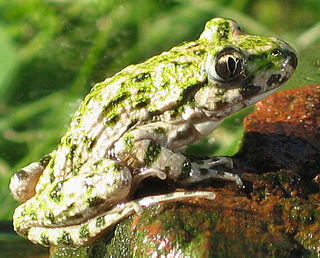
Pelodytidae, also known as the parsley frogs, or rarely, mud divers, is a family of frogs. It contains a single extant genus, Pelodytes, and three genera only known from fossils. The extant species are found in southwestern Europe and the Caucasus.
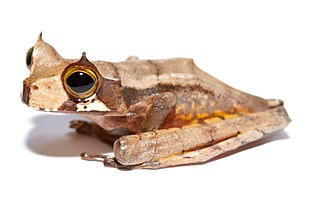
Gastrotheca is a genus of frogs in the family Hemiphractidae. They are found in Central America south of Costa Rica and in South America. Most species occur in the American Cordillera from southern Costa Rica to north-western Argentina. This genus makes up the bulk of marsupial frog diversity; formerly it was placed in the "Leptodactylidae" assemblage.

Euparkerella, sometimes known as Guanabara frogs, is a genus of frogs in the family Strabomantidae. They are endemic to the Atlantic coastal forests in the south-eastern Brazilian states of Espírito Santo and Rio de Janeiro. The name Euparkerella honours H. W. Parker, a herpetologist who named the type species, with the Greek prefix eu meaning true and suffix ella, a diminutive form.

Stefania is a genus of frogs in the family Hemiphractidae. They are native to the highlands of the Guiana Shield in southern Venezuela, Guyana, and adjacent far northern Brazil. Most are restricted to the tepui highlands, but S. evansi also occurs in lowlands. On most mountains there are only 1–2 species from this genus, but five are known from Mount Ayanganna and the neighbouring Mount Wokomung has six species. They are usually found near streams at low levels on branches/leaves or on the ground among vegetation/rocks.

Charadrahyla is a genus of frogs in the family Hylidae. It is endemic to tropical southern Mexico. The generic name was derived from Greek charadra ("ravine") and Hyla, in reference to the habits of these frogs. Accordingly, common name ravine treefrogs has been coined for the genus.
Megastomatohyla is a genus of frogs in the family Hylidae. They are endemic to the cloud forests of central Veracruz and Oaxaca, Mexico. All are rare species with restricted distributions. The generic name is derived from Greek mega (="large") and stem of the genitive stomatos (="mouth"), referring to the enlarged oral disc of the tadpoles, juxtaposed with Hyla, the genus in which the four Megastomatohyla species were previously placed. Common name large-mouthed treefrogs has been coined for this genus.

Ecnomiohyla, commonly known as fringe-limbed treefrogs or marvelous frogs, is a genus of frogs in the family Hylidae. This genus was erected in 2005 following a major revision of Hylidae. The ten original species in this genus were previously placed in the genus Hyla. The generic name Ecnomiohyla comes from Greek ecnomios and Hylas, the companion of Hercules.
Boana latistriata is a species of frog in the family Hylidae. It is endemic to Brazil and only known from its type locality, Itatiaia National Park, and from Marmelópolis, both in the state of Minas Gerais. The specific name latistriata refers to the wide stripes on the back of this frog.

Scarthyla is a genus of tree frogs, the family Hylidae. They are found in the upper Amazon Basin of Bolivia, Peru, and Brazil and northward through Colombia and Venezuela to the Caribbean lowlands. They are sometimes known as Madre de Dios treefrogs and South American aquatic treefrogs. They are semiaquatic.

Cryptobatrachus boulengeri, also known as Boulenger's backpack frog, is a species of frogs in the family Hemiphractidae. It is endemic to Sierra Nevada de Santa Marta in northern Colombia. The specific name honours George Albert Boulenger, an eminent herpetologist.
Cryptobatrachus fuhrmanni commonly known as Fuhrmann's backpack frog is a species of frog belonging to the family Hemiphractidae. It is endemic to Colombia and occurs on all three Andean cordilleras: the eastern slope of the Cordillera Occidental, the northern and eastern flanks of the Cordillera Central, and the western slope of the Cordillera Oriental. The specific name fuhrmanni is in honor of Otto Fuhrmann, a Swiss zoologist and helminthologist.
"Hyla" nicefori also known as the Colombian backpack frog, is a species of frog in the family Hylidae. It is endemic to the border region between Boyacá and Casanare in Colombia and only known from the holotype. The name format, as used by the American Museum of Natural History's Amphibian Species of the World, indicates that while this species is temporarily kept in the hylid type genus Hyla, it belongs elsewhere in the family and will be reassigned pending a taxonomic resolution. It was originally placed in Cryptobatrachus, but a later study revealed a number morphological differences showing that it is not in family Hemiphractidae, instead pointing to it being a hylid frog, perhaps Hyloscirtus.

Craugastoridae, commonly known as fleshbelly frogs, is a family of New World direct-developing frogs. As delineated here, following the Amphibian Species of the World, it contains 129 species. They are found from the southern United States southwards to Central and South America.

The Hemiphractidae are a family of frogs from South and Central America. Previously, this group had been classified as a subfamily (Hemiphractinae) under family Hylidae. More recent research classifies these genera into their own family, or sometimes into three separate families: Amphignathodontidae, Cryptobatrachidae, and Hemiphractidae. An active question still exists as to which of these groupings is more accurate.
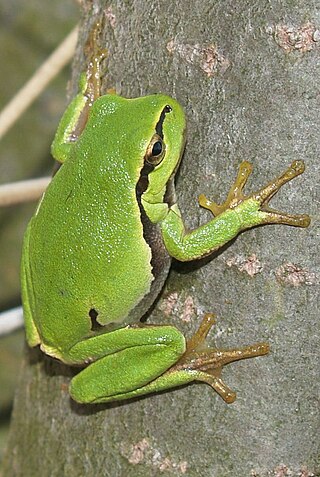
Hylinae is a large subfamily of "tree frogs", family Hylidae.

Ceuthomantis is a small genus of craugastorid frogs, also treated as comprising their own monogeneric family Ceuthomantidae. They are found in the southern and eastern parts of the Guiana Highlands in Venezuela, Guyana, and Brazil. The generic name is derived from the Greek noun mantis, which means treefrog, and adjective keuthos, which means hidden, in allusion to the hidden existence of this genus in the tepuis of the Guiana Shield.
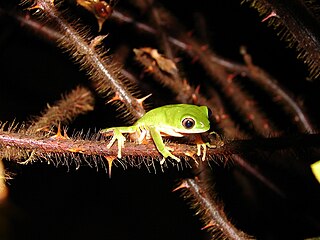
Pithecopus is a genus of frogs in the subfamily Phyllomedusinae. Species of the genus Pithecopus are found in tropical South America east of the Andes, from southern Venezuela to northern Argentina. Resurrected from the synonymy of Phyllomedusa in 2016, it corresponds to the former Phyllomedusa hypochondrialis group. Its sister group is Callimedusa.
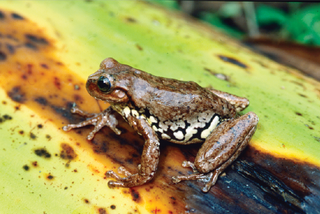
Sarcohyla is a genus of frogs in the family Hylidae. It is endemic to Mexico and is found in the montane parts of the country between Durango in the north and Guerrero in the south. These frogs typically occur in pristine habitats along streams in pine-oak woodland at elevations between 1,500 and 3,100 m above sea level. The generic name is derived from the Greek sarkodes meaning "fleshy" in combination with Hylas and refers to the thick, glandular skin characteristic of most of the species in the genus.

Rheohyla is a genus of frogs in the family Hylidae. As currently recognized, it is monotypic, containing only Rheohyla miotympanum, also known as the small-eared hyla or small-eared treefrog. However, the nominal species likely is a complex of more than one species. It is endemic to eastern and central Mexico. The generic name refers to streams, the breeding habitat of this frog. The specific name is derived from Greek meion, a diminutive prefix, together with Greek tympanon (='drum') and refers to the small tympanum.
Cryptobatrachus ruthveni is a species of frogs in the family Hemiphractidae. It is endemic to the western flank of the Sierra Nevada de Santa Marta in northern Colombia. The specific name ruthveni honors Alexander Grant Ruthven, an American herpetologist who was the first one to study.















